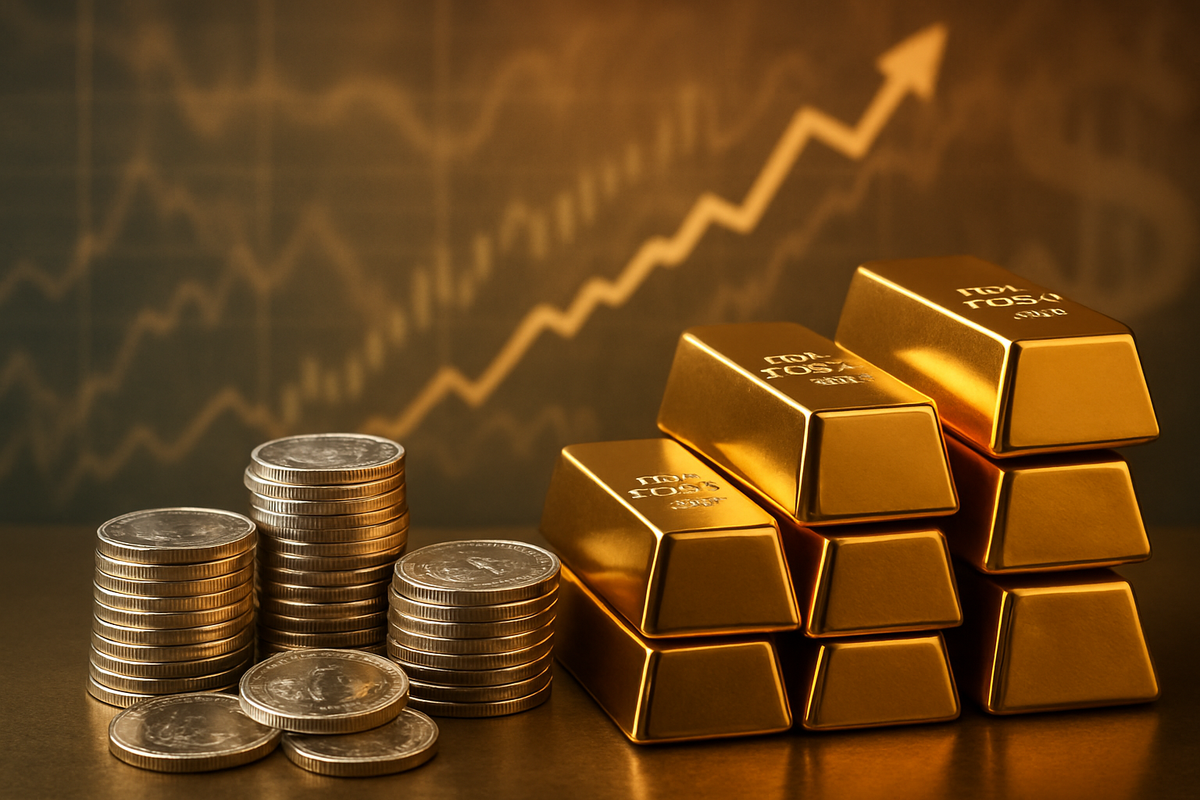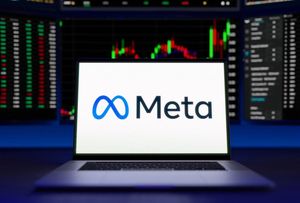
In a financial landscape increasingly defined by persistent inflationary pressures and rising input costs, gold and silver have emerged as prominent beneficiaries, witnessing significant price surges. This rally underscores their enduring appeal as inflation hedges and safe-haven assets, as investors flock to precious metals to preserve purchasing power amidst concerns over currency debasement and economic uncertainty. The dramatic appreciation in their values reflects a global sentiment that these tangible assets offer a crucial bulwark against the erosion of wealth.
The current surge in precious metal valuations is a direct consequence of a complex interplay of economic forces. While headline inflation shows signs of moderating in some advanced economies, core inflation remains stubbornly high, particularly in the United States. This "sticky" inflation, fueled by factors such as corporate consolidation, geopolitical instability, and ongoing supply chain disruptions, has reignited interest in gold and silver, driving their prices to unprecedented levels and highlighting their critical role in diversified investment portfolios.
Unpacking the Precious Metal Rally: A Deep Dive into Inflationary Drivers
The recent ascent of gold and silver prices is not an isolated event but rather a culmination of sustained inflationary pressures and strategic market shifts. Globally, while overall inflation is projected to decline from 6.8% in 2023 to an estimated 4.5% in 2025, core inflation, which excludes volatile food and energy prices, continues to pose a challenge. In the United States, the Consumer Price Index (CPI) registered 2.9% for the 12 months ending August 2025, with the September 2025 report showing a 3.9% rate. This has led to expectations that the Federal Reserve may delay interest rate cuts, further fueling the perception of a prolonged inflationary environment. J.P. Morgan Global Research anticipates a rise in global core inflation to an annualized rate of 3.4% in the latter half of 2025, with US core Personal Consumption Expenditures (PCE) inflation potentially climbing to 4.6% in Q3 2025, partly due to tariff-related spikes.
The timeline of this rally is particularly striking. Gold has experienced a remarkable run, hitting multiple record highs. On October 16, 2025, gold touched $4,326 per ounce, and by October 20, 2025, it was trading above $4,345 per ounce, having reached an all-time high of $4,379.60 earlier in October 2025. This represents an approximate 85% increase from December 2019 to October 2025, significantly outpacing the US CPI increase of about 23% over the same period. Silver has mirrored this strength, with futures jumping approximately 70% in 2025 to trade around $51.82 per troy ounce as of October 17, 2025, briefly touching a record high of $54.47 earlier in the month. By October 20, 2025, spot silver rose to $52.12 per ounce, marking a 78.73% surge since the beginning of 2025.
Key players driving this trend include global central banks, who have been exceptionally strong buyers of gold, acquiring 1,136 tonnes in 2022 and 1,037 tonnes in 2023. Q1 2024 saw 290 tonnes purchased, marking the strongest start to any year on record, with projections for 2025 central bank buying around 900 tonnes. This consistent institutional demand, coupled with sustained safe-haven demand from individual and institutional investors amid geopolitical uncertainties, forms a robust foundation for precious metal prices. Initial market reactions have been overwhelmingly positive, with significant capital flows into precious metal exchange-traded funds (ETFs) and mining stocks.
The effectiveness of gold and silver as inflation hedges is amplified by the environment of low or declining real interest rates, which reduces the opportunity cost of holding non-yielding assets. While gold's relationship with inflation is complex—also serving as a hedge against recession and geopolitical fears—its long-term benefits for portfolio diversification are clear. Silver, with its dual role as a precious metal and an industrial commodity, benefits from strong demand in rapidly growing sectors such as solar panels, electric vehicles (EVs), 5G technology, and semiconductors, providing a structural floor for its prices and making it a compelling asset in the current economic climate.
Market Movers: Winners and Losers in the Precious Metals Boom
The escalating prices of gold and silver are creating a distinct bifurcation within the financial markets, yielding clear winners and presenting significant challenges for others. Companies involved in the extraction and investment of these precious metals are experiencing a boon, while industries heavily reliant on silver as an industrial input face mounting cost pressures.
At the forefront of the beneficiaries are gold and silver mining companies. As the spot prices of these metals climb, miners see a direct increase in their revenues, often leading to disproportionately higher profit margins due to operational leverage. Major gold producers like Newmont Corporation (NYSE: NEM) and Barrick Gold Corporation (NYSE: GOLD) are poised for enhanced profitability, despite facing their own inflationary pressures on labor and production costs. Similarly, silver-focused miners such as Pan American Silver Corp. (NASDAQ: PAAS), First Majestic Silver Corp. (NYSE: AG), and Hecla Mining Co. (NYSE: HL) are witnessing substantial boosts to their top and bottom lines. Streaming and royalty companies like Wheaton Precious Metals Corp. (NYSE: WPM) also benefit immensely, as they secure future production at fixed low prices, capitalizing on the rising spot market without direct operational risks. Precious metal Exchange Traded Funds (ETFs) are also direct beneficiaries, providing investors with liquid exposure to the price movements. Funds like SPDR Gold Trust (NYSEARCA: GLD), iShares Gold Trust (NYSEARCA: IAU), iShares Silver Trust (NYSEARCA: SLV), and abrdn Physical Silver Shares ETF (NYSEARCA: SIVR) have seen significant inflows, reflecting investor confidence in precious metals as an inflation hedge. ETFs focused on mining companies, such as the Global X Silver Miners ETF (NYSEARCA: SIL), offer an amplified response due to the inherent operational leverage of the underlying companies.
Conversely, industries that depend on silver as a crucial raw material are grappling with escalating input costs. Silver's unique properties, such as superior electrical conductivity, make substitution difficult in many applications, leading to price-inelastic demand. The solar panel manufacturing industry is particularly vulnerable, as silver paste is a critical component in photovoltaic (PV) cells. The cost of silver in solar modules has surged to an estimated 14% in 2025 from 5% in 2023, squeezing margins for companies like First Solar, Inc. (NASDAQ: FSLR), JinkoSolar Holding Co., Ltd. (NYSE: JKS), and Canadian Solar Inc. (NASDAQ: CSIQ). These companies are forced to explore "thrifting" strategies or pass on higher costs to consumers.
The broader electronics manufacturing sector, which uses substantial amounts of silver for electrical contacts, solders, and switches, also faces headwinds from elevated raw material expenses. While specific pure-play electronics companies are not always singled out, the entire supply chain, from semiconductor manufacturers to mobile device producers, is impacted. Similarly, the automotive industry, especially Electric Vehicle (EV) manufacturers, utilize significant amounts of silver in wiring and battery systems. Companies like Tesla (NASDAQ: TSLA) and General Motors (NYSE: GM), despite their diversified product lines, will see increased manufacturing costs for their EV segments. Finally, jewelry manufacturers and retailers such as Signet Jewelers (NYSE: SIG) and Tiffany & Co. (NYSE: TIF) (part of LVMH Moët Hennessy Louis Vuitton) are directly affected by the soaring cost of gold and silver, needing to either raise retail prices, potentially impacting demand, or absorb thinner profit margins.
Broader Implications: A Shifting Economic Paradigm
The sustained rally in gold and silver prices, driven by inflationary pressures, is more than just a market event; it signifies a broader recalibration within the global economic landscape. This phenomenon fits squarely into a trend where investors and institutions are increasingly seeking tangible assets as a hedge against currency devaluation and economic instability, moving away from traditional financial instruments that may offer insufficient protection in an inflationary environment. The current scenario echoes historical periods where precious metals served as a refuge during times of economic uncertainty and monetary expansion.
The ripple effects extend across various sectors. For competitors and partners within the mining industry, higher metal prices can spur increased exploration and production, potentially leading to greater competition for resources and talent. However, it also fosters an environment where smaller, high-grade deposits become economically viable, attracting new investments. For industries reliant on silver, the sustained high prices could accelerate innovation in material science, pushing for the development and adoption of alternative, cheaper conductive materials. This could lead to a long-term shift away from silver in certain applications, even if immediate substitution is challenging.
Regulatory and policy implications are also significant. Persistent inflation and the flight to precious metals could intensify pressure on central banks globally, including the Federal Reserve, to tighten monetary policy more aggressively or to maintain higher interest rates for longer. Governments might also face calls to address the root causes of inflation, such as supply chain bottlenecks and market concentration. Furthermore, the increased demand from central banks for gold could be interpreted as a strategic move to diversify reserves away from fiat currencies, signaling a potential shift in the global financial architecture and a challenge to the dominance of the US dollar.
Historically, the role of gold as an inflation hedge was prominently demonstrated during the inflationary 1970s, where it delivered substantial real returns. More recently, from December 2019 to October 2025, gold's 85% increase significantly outpaced the US CPI's 23% rise, showcasing its continued efficacy. Silver, while more volatile due to its industrial demand component, has also shown strong performance during periods of economic growth coupled with inflation concerns. The current environment, characterized by geopolitical instability, trade disputes, and supply chain disruptions, creates a fertile ground for precious metals to thrive, drawing parallels to past crises where tangible assets proved their worth. This sustained interest in gold and silver reflects a growing lack of confidence in traditional financial systems' ability to fully mitigate the risks posed by ongoing inflationary pressures.
What Comes Next: Navigating the Future of Precious Metals
The trajectory for gold and silver, propelled by persistent inflationary pressures, points towards continued appreciation in the short to long term, presenting both opportunities and challenges for investors and industries alike. While short-term volatility is always a factor, the underlying fundamentals suggest a robust future for these precious metals as essential components of a resilient portfolio.
In the short term (late 2025 - mid-2026), gold is anticipated to maintain its upward momentum, potentially trading between $3,700 and $4,200 per ounce, with strong support likely to form around the $4,000-$4,100 range after its rapid appreciation in 2025. This is driven by ongoing geopolitical tensions, economic uncertainties, and the expectation of Federal Reserve interest rate cuts. Silver, having also seen a remarkable surge, is expected to consolidate around the $50-$55 range, though with higher volatility, underpinned by tight physical supply and robust industrial demand. Long-term forecasts are even more bullish, with gold projected to reach $4,700 per ounce by Q1 2026 and potentially $5,000 to $6,000 per ounce by 2026, with some aggressive predictions hinting at $10,000 by 2030. Silver's long-term outlook is similarly strong, with predictions of $78 per ounce by late 2026 and potentially $100 in 2027, driven by a deepening structural supply deficit projected to widen to 150-200 million ounces annually by 2026-2028.
Potential strategic pivots or adaptations for investors include maintaining a well-diversified portfolio with a significant allocation to precious metals as a long-term hedge. A "buy the dip" strategy could prove effective during periods of short-term corrections. For industries reliant on silver, continued investment in R&D for alternative materials and "thrifting" strategies will be crucial to mitigate rising input costs. Market opportunities abound for gold and silver miners, as well as precious metal streaming and royalty companies, which stand to benefit from sustained high prices. Challenges include potential headwinds from a strengthening U.S. dollar or a more hawkish central bank stance, though current trends suggest a more dovish pivot.
Possible scenarios range from inflation remaining high, which would see gold continue its upward trajectory and silver potentially outperforming due to its dual nature and supply deficits, to a moderation in inflation, where precious metals might still be supported by central bank demand and geopolitical uncertainty but with more modest gains. A less probable but higher-impact scenario involves accelerated surges due to unexpected economic shocks or severe geopolitical escalation, which would further reinforce the defensive benefits of gold and silver. Investors should closely monitor central bank policies, particularly interest rate decisions and ongoing gold purchases by global central banks, which provide significant demand support. For silver, tracking trends in the green energy transition, particularly solar energy deployment and EV sales, will be critical due to its substantial and growing industrial demand component.
Comprehensive Wrap-up: Enduring Value in Turbulent Times
The ongoing surge in gold and silver prices, fueled by persistent inflationary pressures and a complex global economic environment, unequivocally reaffirms their critical role as inflation hedges and safe-haven assets. The dramatic price appreciation witnessed in 2025, with gold surpassing $4,300 per ounce and silver exceeding $50 per ounce, underscores a fundamental shift in investor sentiment towards tangible assets that can preserve purchasing power in an era of currency debasement and heightened uncertainty.
Moving forward, the market for precious metals appears poised for continued strength. Key takeaways include the sustained demand from global central banks for gold, indicating a strategic diversification away from fiat currencies, and the robust, structurally growing industrial demand for silver, particularly from the green energy sector. While gold offers a more direct hedge against inflation and geopolitical risk, silver's dual role provides additional leverage during periods of economic growth coupled with inflationary concerns. The challenges of a strengthening U.S. dollar or a significant shift in central bank hawkishness remain, but current forecasts suggest these are less likely to derail the overall bullish trend.
Investors should continue to watch for several key indicators in the coming months. These include central bank policy statements regarding interest rates and quantitative easing, any escalation or de-escalation of global geopolitical tensions, and the continued pace of industrial adoption of silver in emerging technologies. The gold-to-silver ratio, currently around 80.07, also offers insights, suggesting silver may still be undervalued relative to gold and could offer greater upside potential. Ultimately, the current environment reinforces the long-standing principle that precious metals offer an essential component for portfolio diversification and wealth preservation, especially in turbulent times marked by persistent inflation. Their enduring value is not merely a historical anecdote but a living reality in today's financial markets.
This content is intended for informational purposes only and is not financial advice





